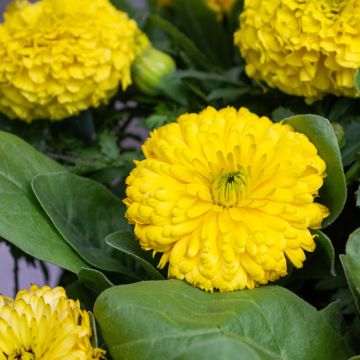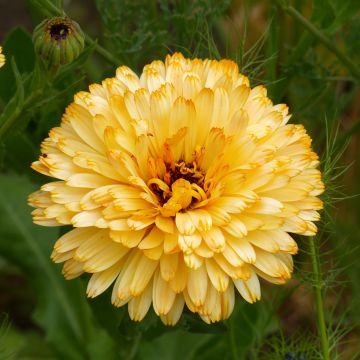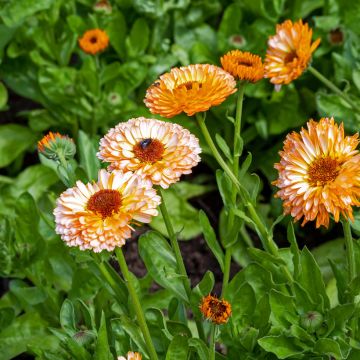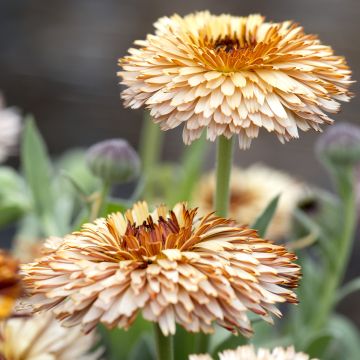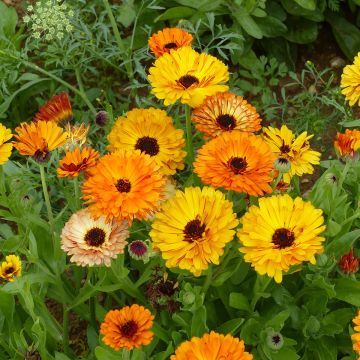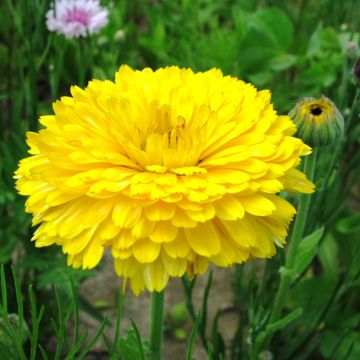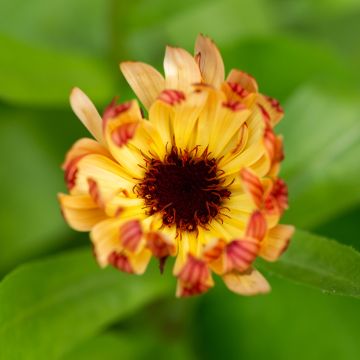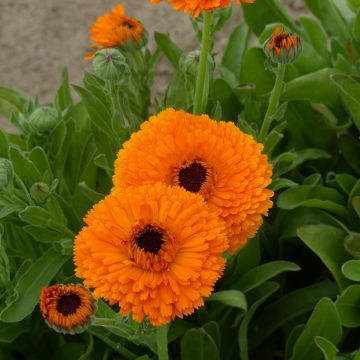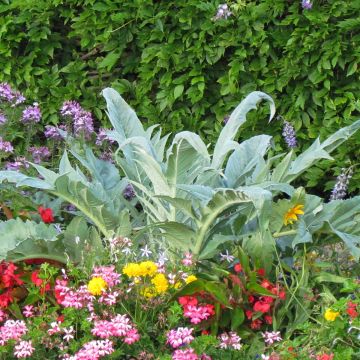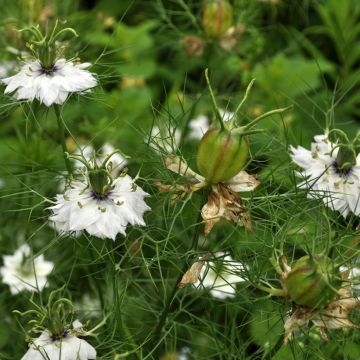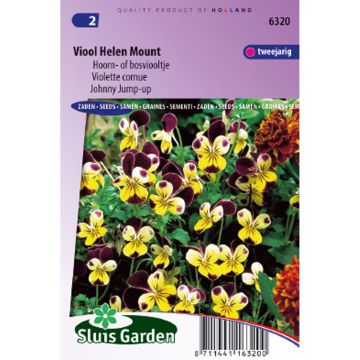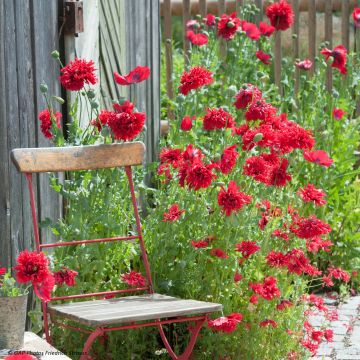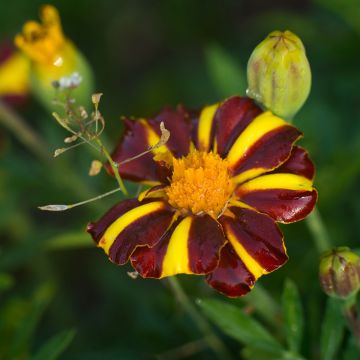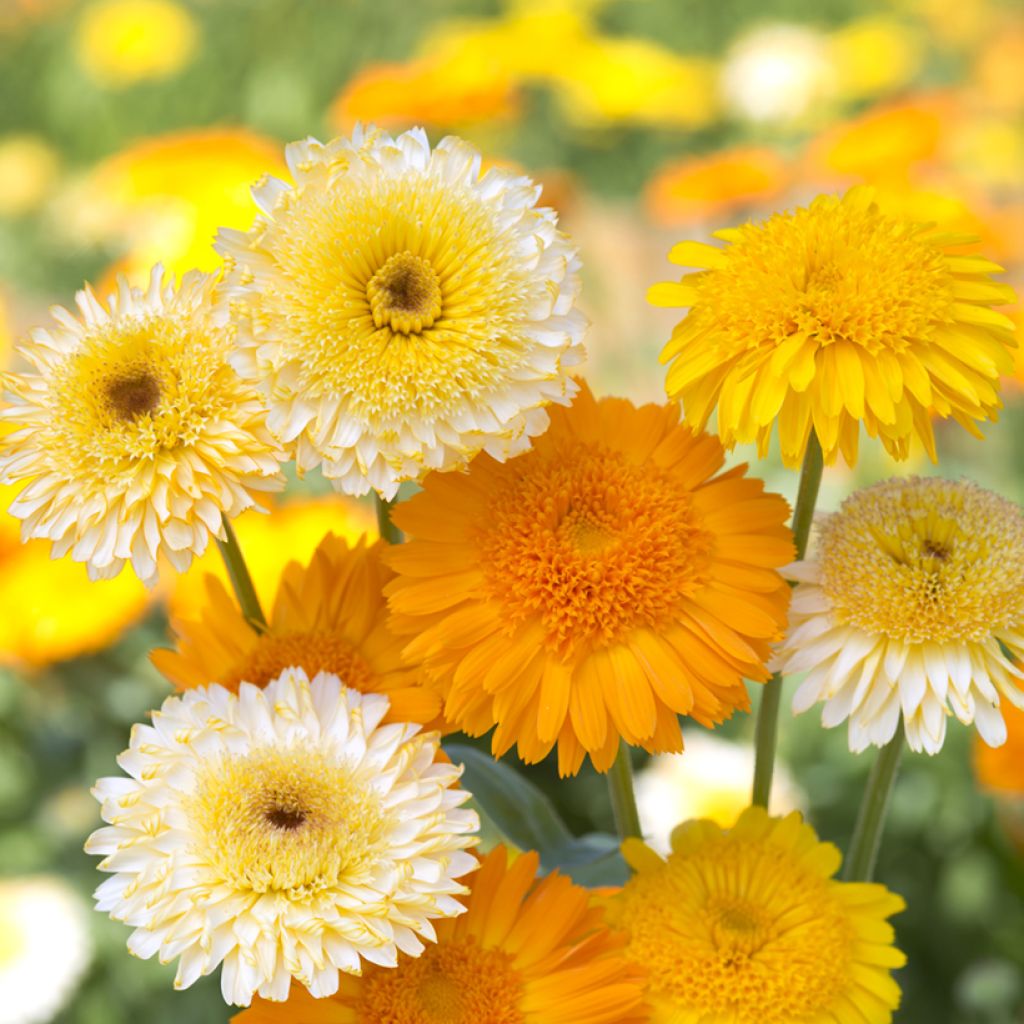

Calendula officinalis Kinglet Mix Seeds- Pot Marigold
Calendula officinalis Kinglet Mix Seeds- Pot Marigold
Calendula officinalis Kinglet Mix
Pot Marigold, Common Marigold, Scotch Marigold
This item cannot be shipped to the selected country
Dispatch by letter from €3.90
More information
Schedule delivery date,
and select date in basket
This plant carries a 6 months recovery warranty
More information
We guarantee the quality of our plants for a full growing cycle, and will replace at our expense any plant that fails to recover under normal climatic and planting conditions.
Seed-only orders are dispatched by sealed envelope. The delivery charge for seed-only orders is €3.90.
Does this plant fit my garden?
Set up your Plantfit profile →
Description
The 'Kinglet Mix' Marigold is a new variety of Calendula officinalis in a mix that brings a refreshing touch to the genre. It consists equally of flowers in shades of golden apricot, dark lemon yellow (sometimes with almost white outer petals), and rich orange. Two or three rows of long petals surround a tight cushion of shorter petals, forming a ridge-shaped dome at the centre. This annual plant forms a medium-sized, very floriferous, sturdy plant that is wind-resistant and fits well in sunny borders and containers, bringing them to life for weeks. Easy to grow in ordinary soil, it is sown between March and April and starts flowering approximately ten weeks after sowing.
The Calendula officinalis belongs to the aster family, possessing the characteristic inflorescence in the form of a daisy-like head. 'Kinglet Mix' is a recent variety. The annual plant forms a clump of strong, ramified stems in a few months, giving it a compact appearance. It reaches a height of 45 to 60 cm and a width of 40 cm. Its lanceolate leaves are velvety and highly aromatic when crushed. Their bright green colour provides a beautiful setting for its cheerful flowers. Its flowering starts in June and continues regularly until late summer, attracting numerous pollinating insects. Each head is composed of a centre of fertile florets surrounded by many long "petals" which are actually ligulate flowers gathered in a crown. This crown opens in the sun and closes at night or in overcast weather. The seeds of the Marigold spread easily in various ways: by the wind, falling to the ground, but also by clinging to clothes and animal fur, as these small hooks are barbed. They self-sow easily as their germination is not hindered by the cold. Seedlings thrive in all types of soil, as long as they receive ample sunlight throughout the day.
The 'Kinglet Mix' Marigold is a wise choice for those looking to quickly create a flowery border or fill a container on a sunny terrace. This plant harmonizes well with colourful Dahlias and swaying ornamental grasses. It is also enhanced by foliage plants such as artemisias or silver stachys, as well as tansies. Salvias, roses, and Love-in-a-Mist Nigellas form perfect duos with calendulas. Besides its ornamental qualities, calendula is an edible flower to be enjoyed in moderation, adding flavour to salads, soups, or desserts, reminiscent of a peppery taste.
Listed in gardens since the 12th century, the Marigold has virtues utilised in various fields. Primarily a dye plant used for pigment, it is also employed in cosmetics, pharmacology, and homeopathy for its soothing, astringent, healing, anti-inflammatory, and hepatic properties, among others. Its nickname of Faux Saffron comes from its culinary use. Indeed, the Marigold effectively substitutes this spice by colouring rice dishes, stews, soups, and herbal teas. When raw, it flavours cheeses, salads, and even butter. Furthermore, it has long been established in the vegetable garden as an ally to other edibles, as it repels nematodes and attracts numerous pollinating insects.
Report an error about the product description
Flowering
Foliage
Plant habit
Botanical data
Calendula
officinalis
Kinglet Mix
Asteraceae
Pot Marigold, Common Marigold, Scotch Marigold
Cultivar or hybrid
Other Marigold seeds
Planting and care
The Marigold Kinglet Mix can be sown directly in place from March in mild regions. If you are in a cold region, wait until the end of strong frosts, as the seeds prefer temperatures around 20°C. Loosen the soil a bit and choose a sunny location. The seeds will be sown by broadcasting, covered with 1 or 2 mm of soil, and lightly watered. They will germinate between 5 and 10 days and you can thin them out if necessary by spacing them 30 cm apart.
However, if you are not afraid of strong winter frosts, you can prepare your sowings as early as September by sowing in buckets and keeping them sheltered until spring. You can then transplant the shoots from March in pots or directly in the ground to benefit from some earliness.
Cultivation:
Marigolds are fast-growing plants that thrive in the sun or partial shade in warm climates and sheltered positions. They are undemanding, as long as they are planted in well-drained, fairly fertile, light soil. Protect the plants from slugs and snails, which are fond of them.
Sowing period
Intended location
This item has not been reviewed yet - be the first to leave a review about it.
Flower seeds
Haven't found what you were looking for?
Hardiness is the lowest winter temperature a plant can endure without suffering serious damage or even dying. However, hardiness is affected by location (a sheltered area, such as a patio), protection (winter cover) and soil type (hardiness is improved by well-drained soil).

Photo Sharing Terms & Conditions
In order to encourage gardeners to interact and share their experiences, Promesse de fleurs offers various media enabling content to be uploaded onto its Site - in particular via the ‘Photo sharing’ module.
The User agrees to refrain from:
- Posting any content that is illegal, prejudicial, insulting, racist, inciteful to hatred, revisionist, contrary to public decency, that infringes on privacy or on the privacy rights of third parties, in particular the publicity rights of persons and goods, intellectual property rights, or the right to privacy.
- Submitting content on behalf of a third party;
- Impersonate the identity of a third party and/or publish any personal information about a third party;
In general, the User undertakes to refrain from any unethical behaviour.
All Content (in particular text, comments, files, images, photos, videos, creative works, etc.), which may be subject to property or intellectual property rights, image or other private rights, shall remain the property of the User, subject to the limited rights granted by the terms of the licence granted by Promesse de fleurs as stated below. Users are at liberty to publish or not to publish such Content on the Site, notably via the ‘Photo Sharing’ facility, and accept that this Content shall be made public and freely accessible, notably on the Internet.
Users further acknowledge, undertake to have ,and guarantee that they hold all necessary rights and permissions to publish such material on the Site, in particular with regard to the legislation in force pertaining to any privacy, property, intellectual property, image, or contractual rights, or rights of any other nature. By publishing such Content on the Site, Users acknowledge accepting full liability as publishers of the Content within the meaning of the law, and grant Promesse de fleurs, free of charge, an inclusive, worldwide licence for the said Content for the entire duration of its publication, including all reproduction, representation, up/downloading, displaying, performing, transmission, and storage rights.
Users also grant permission for their name to be linked to the Content and accept that this link may not always be made available.
By engaging in posting material, Users consent to their Content becoming automatically accessible on the Internet, in particular on other sites and/or blogs and/or web pages of the Promesse de fleurs site, including in particular social pages and the Promesse de fleurs catalogue.
Users may secure the removal of entrusted content free of charge by issuing a simple request via our contact form.
The flowering period indicated on our website applies to countries and regions located in USDA zone 8 (France, the United Kingdom, Ireland, the Netherlands, etc.)
It will vary according to where you live:
- In zones 9 to 10 (Italy, Spain, Greece, etc.), flowering will occur about 2 to 4 weeks earlier.
- In zones 6 to 7 (Germany, Poland, Slovenia, and lower mountainous regions), flowering will be delayed by 2 to 3 weeks.
- In zone 5 (Central Europe, Scandinavia), blooming will be delayed by 3 to 5 weeks.
In temperate climates, pruning of spring-flowering shrubs (forsythia, spireas, etc.) should be done just after flowering.
Pruning of summer-flowering shrubs (Indian Lilac, Perovskia, etc.) can be done in winter or spring.
In cold regions as well as with frost-sensitive plants, avoid pruning too early when severe frosts may still occur.
The planting period indicated on our website applies to countries and regions located in USDA zone 8 (France, United Kingdom, Ireland, Netherlands).
It will vary according to where you live:
- In Mediterranean zones (Marseille, Madrid, Milan, etc.), autumn and winter are the best planting periods.
- In continental zones (Strasbourg, Munich, Vienna, etc.), delay planting by 2 to 3 weeks in spring and bring it forward by 2 to 4 weeks in autumn.
- In mountainous regions (the Alps, Pyrenees, Carpathians, etc.), it is best to plant in late spring (May-June) or late summer (August-September).
The harvesting period indicated on our website applies to countries and regions in USDA zone 8 (France, England, Ireland, the Netherlands).
In colder areas (Scandinavia, Poland, Austria...) fruit and vegetable harvests are likely to be delayed by 3-4 weeks.
In warmer areas (Italy, Spain, Greece, etc.), harvesting will probably take place earlier, depending on weather conditions.
The sowing periods indicated on our website apply to countries and regions within USDA Zone 8 (France, UK, Ireland, Netherlands).
In colder areas (Scandinavia, Poland, Austria...), delay any outdoor sowing by 3-4 weeks, or sow under glass.
In warmer climes (Italy, Spain, Greece, etc.), bring outdoor sowing forward by a few weeks.

































